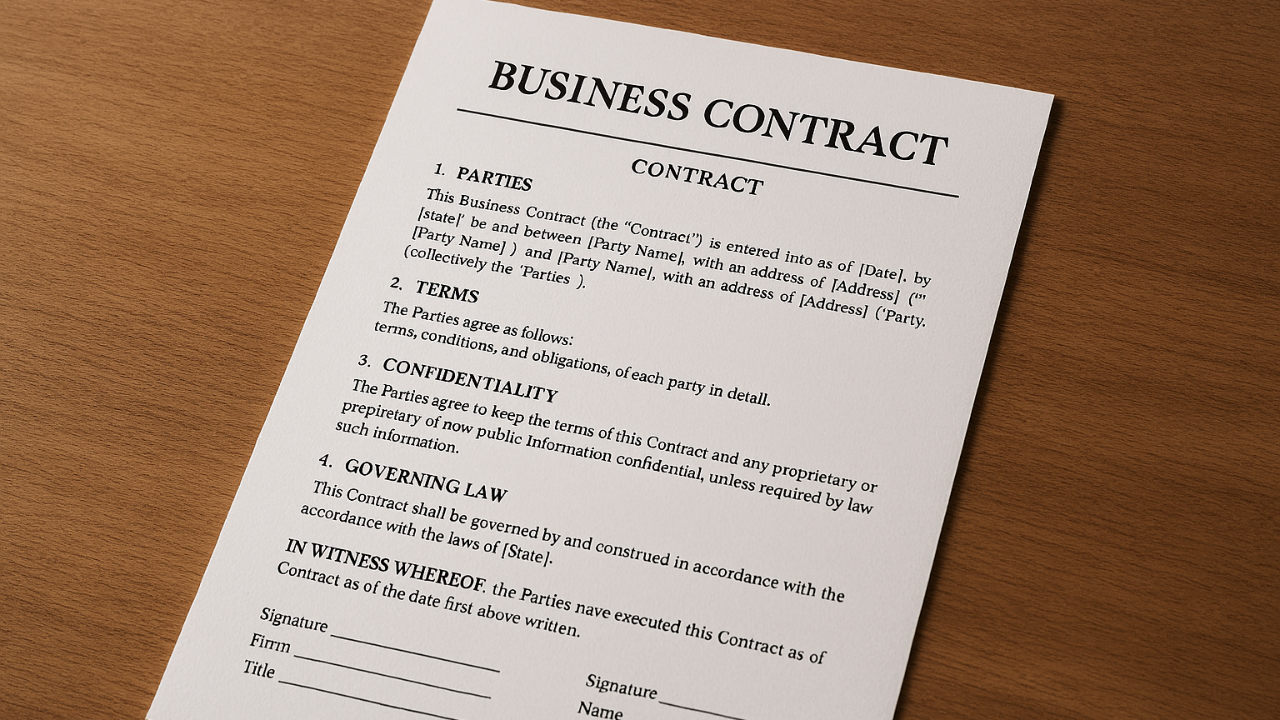Why Are Contracts Important for Business Success?

Contracts might not be the flashiest part of running a business, but they’re one of the most powerful tools you have. Think of them as the backbone of every smooth partnership, project, and transaction. When expectations are clear and responsibilities are spelled out, everyone can do better work with fewer surprises. Here’s a closer look at why contracts matter so much—and why skipping them can cost you more than you think.
1. They Set Clear Expectations
A good contract lays out exactly what each party is supposed to do. It covers deliverables, timelines, payment terms, and standards of quality. When everyone sees the same agreement in writing, it reduces misunderstandings and helps projects stay on track. Instead of relying on memory or verbal promises, you have a solid reference point that keeps things moving smoothly.
2. They Protect Your Business
Contracts act like a safety net. If a client doesn’t pay, a supplier backs out, or a partner doesn’t deliver, the agreement gives you...
Legal Considerations When Expanding Your Family Business

Expanding a family business is an exciting milestone. It’s a sign that your hard work, reputation, and brand have reached a point where growth is the natural next step. But before signing a new lease, hiring more staff, or entering new markets, it’s crucial to understand the legal implications of expansion. A solid legal foundation protects your family’s legacy and ensures the business continues to thrive as it grows.
Choose the Right Business Structure

When a family business expands—whether by opening new branches, adding partners, or entering new industries—its original structure may no longer be the best fit. For example, a small sole proprietorship might need to transition into a corporation or limited liability company (LLC) to protect personal assets and simplify ownership transfers. Consult a business attorney or tax advisor to determine the best structure for your goals. This decision affects taxes, liability, and how ownership is shared among family members.
Read more: Ho...
Succession Strategies to Keep Your Family Business Thriving Across Generations

Family businesses are the backbone of many economies, built on hard work, shared values, and long-term vision. But as founders age and the next generation steps up, the challenge becomes not just maintaining success—but passing it on effectively. Without a clear succession strategy, even the strongest businesses can stumble during transitions. The key lies in planning early, communicating openly, and preparing the next generation to lead confidently.
Start Planning Early
Succession planning shouldn’t wait until retirement is around the corner. In fact, the best time to start is when business is stable. Early planning allows for thoughtful decision-making and time to mentor future leaders. Create a timeline that outlines how leadership responsibilities will gradually shift, giving successors the opportunity to learn and grow under the current leadership’s guidance. This approach reduces uncertainty and helps maintain operational continuity.
Identify and Develop the Right Successor
C...
Contract Clauses That Keep Your Business Safe During Crises

When unexpected events hit—like a natural disaster, pandemic, or supply chain disruption—contracts can make or break your business’s ability to survive. Strong contract clauses don’t just define what’s supposed to happen when things go right; they protect you when things go wrong. Here are the key provisions every business owner should understand and include to stay secure during times of crisis.
1. Force Majeure: The “Act of God” Clause
This is the most well-known crisis-related clause, and for good reason. A force majeure clause frees both parties from liability if extraordinary events prevent them from fulfilling their contractual obligations. Think natural disasters, wars, government shutdowns, or pandemics—events beyond your control.
To make this clause effective, it needs to be specific. Instead of vague phrases like “unforeseeable circumstances,” clearly list what qualifies: epidemics, cyberattacks, labor strikes, and other relevant risks. Also, include requirements for promp...
What Happens to Your Business if You Become Incapacitated?

Most business owners plan for growth, taxes, and even retirement—but few stop to think about what happens if they suddenly can’t run the business due to illness, injury, or mental incapacity. It’s not a pleasant thought, but it’s one of the most important “what ifs” you can prepare for. Without a plan, your absence could lead to confusion, financial losses, or even the collapse of the business you’ve worked so hard to build.
The Reality of Incapacity
Incapacity isn’t limited to old age. It can happen at any time through an accident, stroke, or sudden illness. If you’re the key decision-maker or the face of your company, your temporary or permanent inability to work could bring operations to a standstill. Payroll, contracts, and client relationships might suffer, and employees may be left uncertain about what to do next.
When that happens, who has the legal authority to step in? Without clear documentation, even your spouse or business partner might not have the right to sign checks,...
Why Leadership Transitions Fail and How Legal Planning Can Save Your Business

Leadership changes are among the most vulnerable moments in a company’s life cycle. Whether it’s the retirement of a founder, the promotion of a rising executive, or the transfer of ownership to the next generation, transitions often bring uncertainty. Studies consistently show that many businesses either falter or collapse during this period—not because the company lacked talent, but because the handover wasn’t planned with enough foresight. The good news is that legal planning can turn what is often a stumbling block into a smooth, strategic process.
Why Leadership Transitions Fail
Several common pitfalls explain why businesses struggle when leadership shifts:
1. Lack of succession planning.
Many business owners delay creating a succession plan, either due to optimism, discomfort with the topic, or an assumption that a replacement will naturally step in. Without a roadmap, the organization may scramble, leaving decision-making fragmented.
2. Ambiguity in roles and authority.
If...
Opening a New Location? Here’s What to Know Legally

Expanding your business by opening a new location is an exciting milestone. It often signals growth, stability, and increased demand for your products or services. But before you cut the ribbon, it’s important to understand the legal considerations involved. Overlooking these details can lead to costly delays or disputes down the road. Here’s what you need to know legally before opening that new branch.
1. Choose the Right Business Structure
If your business operates as a sole proprietorship or partnership, opening additional locations may expose you to greater liability. Many owners consider restructuring into a limited liability company (LLC) or corporation when expanding. This helps protect personal assets and simplifies managing multiple branches under one legal entity. If you’re already incorporated, you’ll need to decide whether to operate the new location as part of the existing entity or form a subsidiary.
2. Review Zoning and Local Ordinances
Not every property is suitable...
Franchising Your Business: Key Legal Steps to Take First

Franchising can be one of the fastest ways to grow a successful business. By allowing others to replicate your model under your brand, you expand your reach while benefiting from franchise fees and royalties. However, franchising isn’t as simple as granting permission to use your name. It’s a legal process with strict requirements designed to protect both franchisors and franchisees. If you’re considering this path, here are the key legal steps you need to take first.
1. Confirm Your Business Is Franchise-Ready
Before drafting contracts or recruiting franchisees, assess whether your business is prepared to scale. A franchise model works best for businesses with a proven track record, recognizable brand, and replicable operations. You’ll also need training systems, marketing support, and supply chain logistics in place to ensure franchisees can succeed under your guidance.
2. Develop a Franchise Disclosure Document (FDD)
In many jurisdictions, including the U.S., the law requires fr...
How to Avoid Common Mistakes in Business Contracts

Business contracts are where expectations meet reality. A well‑drafted agreement protects cash flow, relationships, and reputation; a sloppy one invites disputes. Here are the most common pitfalls—and how to avoid them—so your next contract is clear, fair, and enforceable.
1. Vague scope and deliverables
The #1 source of conflict is ambiguity. Define the scope with precision: what’s included, what’s excluded, and how “done” is measured. Add milestones, acceptance criteria, file formats, service levels, and who supplies what. If you can’t verify it, it’s not clear enough.
2. Slippery payment terms
Spell out price, currency, deposit, invoicing schedule, payment method, due dates, late fees, and interest. Tie payments to milestones or deliverables, not vague dates. Add consequences for non‑payment (pause rights or termination) and who pays taxes and bank fees.
3. No change‑control process
Projects evolve, budgets explode. Require written change orders that specify the revised scope,...
How to Structure Real Estate Partnerships

Real estate partnerships can be a powerful way to scale your investment portfolio, share risk, and combine complementary skills and resources. Whether you're teaming up with a friend, family member, or professional investor, the structure of your partnership can make or break your success. Clear agreements, well-defined roles, and legal protections are essential. Here's a practical guide on how to structure real estate partnerships the right way.
1. Choose the Right Partnership Type
Before anything else, you need to decide what type of partnership works best for your goals. The most common structures include:
- General Partnership (GP): All partners share equal responsibility and liability. This is the simplest form, but it also carries the most personal risk.
- Limited Partnership (LP): One or more general partners manage the operations and bear full liability, while limited partners contribute capital and have limited liability.
- Limited Liability Company (LLC): Often the preferred...